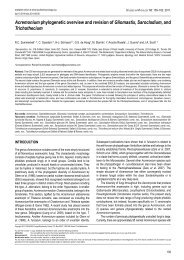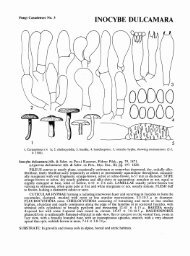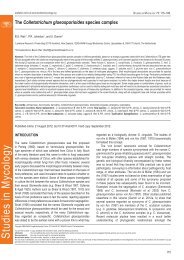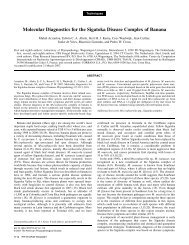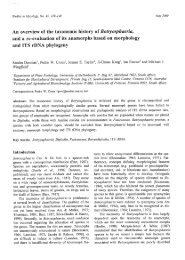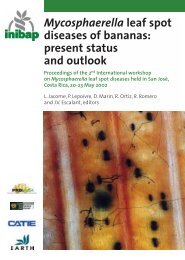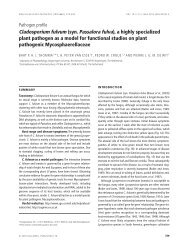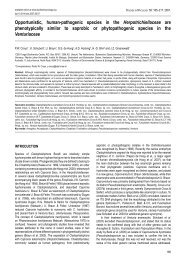Hypocrea rufa/Trichoderma viride: a reassessment, and ... - CBS
Hypocrea rufa/Trichoderma viride: a reassessment, and ... - CBS
Hypocrea rufa/Trichoderma viride: a reassessment, and ... - CBS
You also want an ePaper? Increase the reach of your titles
YUMPU automatically turns print PDFs into web optimized ePapers that Google loves.
the tree, the “Large Viridescens” clade, splits into<br />
two independent evolutionary lineages. The terminal<br />
position of the larger one represents a compact <strong>and</strong><br />
well defined subclade with significant statistical support<br />
that contains isolates of the former Vd group (Lieckfeldt<br />
et al. 1999), described as H. <strong>viride</strong>scens below.<br />
Similar to H. <strong>rufa</strong>, this species has mainly European<br />
origin, also nearly all primary European nodes include<br />
North American, Central American, Asian <strong>and</strong> Pacific<br />
isolates, suggesting the absence of recent allopatric<br />
speciation in this group of isolates. Another wellsupported<br />
clade in the vicinity of H. <strong>viride</strong>scens is<br />
composed of isolates of H. vinosa. As in the “Large<br />
Viride” clade this branch contains representatives of<br />
several well-supported speciation nodes composed of<br />
strains that are closely related to H. <strong>viride</strong>scens <strong>and</strong><br />
H. vinosa <strong>and</strong> undoubtedly represent yet undescribed<br />
species of <strong>Hypocrea</strong>/<strong>Trichoderma</strong>. This diversity will be<br />
discussed in subsequent publications following further<br />
investigations <strong>and</strong> sampling. The material summarised<br />
in this study is sufficient to prove the existence of another<br />
phylogenetic species with eidamia-like morphology that<br />
occupies the second independent lineage within the<br />
“Large Viridescens” clade. The new species T. gamsii<br />
forms a homogeneous clade mainly represented by<br />
isolates from undisturbed soils in Sardinia <strong>and</strong> Central<br />
Russia. As in the case of H. <strong>viride</strong>scens <strong>and</strong> H. <strong>rufa</strong>,<br />
T. gamsii did not evolve as a result of any geographic<br />
isolation since we also sampled isolates from North<br />
America <strong>and</strong> Australia. We describe the most distant<br />
member of the “Large Viridescens” Clade, once again<br />
a single strain, as T. neokoningii. The detailed analysis<br />
of the highly variable intron sequences of the tef1 gene<br />
has clearly shown that, despite their close relationship,<br />
H. <strong>rufa</strong>, H. <strong>viride</strong>scens, H. vinosa, <strong>and</strong> a large group of<br />
isolates that we describe here as T. gamsii represent<br />
distinct sympatric phylogenetic species.<br />
Most of the <strong>Trichoderma</strong> species that have warted<br />
conidia fall within one of these two large clades.<br />
Exceptions include T. saturnisporum <strong>and</strong> T. ghanense,<br />
both of which are members of the distantly related T. sect.<br />
Longibrachiatum (Samuels et al. 1998) <strong>and</strong> clade Ve (Fig.<br />
1). Clade Ve will be discussed in a future publication.<br />
All members of the “Large Viridescens” clade are<br />
characterised by the formation of peculiar, percurrently<br />
proliferating phialides that are diagnostic of Eidamia<br />
<strong>viride</strong>scens, the ex-type of which (<strong>CBS</strong> 433.34) falls in<br />
T. <strong>viride</strong>scens.<br />
Phenotype: anamorph <strong>and</strong> cultures<br />
DNA sequences referred eighty-seven strains to<br />
the “Large Viridescens” clade <strong>and</strong> thirty-four to the<br />
“Large Viride” clade. All of these fungi are typical of<br />
<strong>Trichoderma</strong> in producing copious amounts of green<br />
conidia in pustules or in extensive “lawns” on CMD,<br />
PDA <strong>and</strong> SNA. There was a tendency for conidia to<br />
form more quickly on SNA than on CMD or PDA <strong>and</strong><br />
often conidia did not form on either of the latter media<br />
while they did form on SNA. Of the three media, SNA<br />
is overall better for the study of fungi in the <strong>viride</strong> clade<br />
in terms of more reliable production of conidia. The<br />
endophytic T. scalesiae only produced conidia on SNA<br />
HYPOCREA RUFA / TRICHODERMA VIRIDE<br />
to which a 1 cm<br />
143<br />
2 piece of sterile filter paper had been<br />
added; the conidia only formed at the interface of the<br />
paper <strong>and</strong> the agar <strong>and</strong> on the paper itself.<br />
There was a tendency for yellow pigment to develop<br />
in conidia in colonies of the “Large Viridescens” clade<br />
grown on PDA <strong>and</strong> SNA at 25 °C for two weeks, <strong>and</strong> a<br />
yellow pigment often diffused through CMD. No pigment<br />
was noted on SNA. Diffusing yellow pigmentation was<br />
not noted in colonies belonging to the “Large Viride”<br />
clade. A more or less strong coconut odour was<br />
detected in PDA <strong>and</strong> CMD cultures of most members<br />
of the “Large Viridescens” clade.<br />
Conidia tended to form in pulvinate to hemispherical<br />
pustules < 1–3 mm diam. Distinct pustules measuring<br />
1–5 mm were formed in T. <strong>viride</strong>/H. <strong>rufa</strong> on CMD. While<br />
pustules formed in T. <strong>viride</strong>scens/H. <strong>viride</strong>scens reached<br />
3 mm diam, most often they measured less than 1 mm<br />
<strong>and</strong> often no pustules were formed, the conidiophores<br />
arising in more or less continuous cottony lawns. Often<br />
conidiophores formed apart from the larger pustules<br />
in the aerial hyphae <strong>and</strong> in minute tufts. Pustules in<br />
both groups tended to be cottony, <strong>and</strong> individual fertile<br />
branches could be seen; often conidiophores protruded<br />
beyond the surface of a pustule, producing a single<br />
phialide or a few fertile branches near the tip, the rest<br />
of the conidiophore remaining sterile or nearly so. The<br />
pustules of T. <strong>viride</strong>scens were usually less compact<br />
than in T. <strong>viride</strong>, <strong>and</strong> transparent under a 10 × objective.<br />
In pustules of T. <strong>viride</strong> produced on CMD, conidia often<br />
appeared to form at the surface of the pustule. In all<br />
cases, after one week at 20–25 °C, conidia were deep<br />
green to dark green 27–28D–F6–8, although lighter<br />
green conidia were observed in younger cultures. In<br />
some cultures of T. <strong>viride</strong>scens grown at 25 °C under<br />
alternating light on CMD <strong>and</strong> SNA, conidial masses<br />
were yellow. Conidia of T. neokoningii on PDA often<br />
were yellow at first. Often conidia of members of the<br />
“Large Viridescens” clade became greenish yellow<br />
when mounted in 3 % KOH.<br />
Most of the fungi discussed in this work produce<br />
colonies that are recognizable as typical of <strong>Trichoderma</strong><br />
in producing green conidia in abundance on most media.<br />
The exception is T. scalesiae, which only produced<br />
conidia sparingly on SNA to which a 1 cm2 piece of<br />
sterile filter paper had been added. Conidiophores<br />
in this species were irregularly branched, similar to<br />
what was described for T. paucisporum Samuels et<br />
al. (Samuels et al. 2006b) <strong>and</strong> for synanamorphs<br />
of pustulate species of <strong>Trichoderma</strong> (Chaverri et al.<br />
2004). Conidia were held in drops of clear liquid, which<br />
appeared yellow to pale green because of the conidia,<br />
at the tips of the phialides.<br />
The following results pertain to the remaining species<br />
discussed in this work. It is difficult or impossible to<br />
define a conidiophore in <strong>Trichoderma</strong>. Conidiophores<br />
are mostly formed in pustules. As was noted above,<br />
pustules tend to be composed of intertwined hyphae<br />
that terminate in fertile branching systems. For the<br />
purposes of the present discussion, the conidiophore<br />
is referred to as the terminal branching system of<br />
intertwined hyphae that form the pustule. Various<br />
types of conidiophores were encountered in this study,




